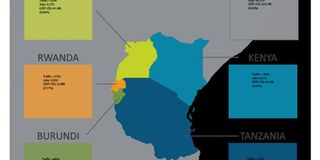Air transport liberalisation to create 46,000 jobs for EAC per year - study

What you need to know:
- Mr Erick Ntagengerwa, the senior transport economist at the EAC Secretariat said they have created different tourism circuits that will help in promoting liberalisation of air space.
- Over the last 10 years, intra-EAC traffic has grown by a compound annual growth rate of 3.4 per cent (ranging from 2.7 per cent for Burundi to 4.2 per cent for Uganda).
Kampala. Liberalisation of air transport amongst the five East African states will create 46,320 jobs for the locals, a new study has shown.
The study dubbed ‘Cost and Benefits of Open Skies in the EAC’ released in Nairobi on Wednesday also shows that liberalisation of air transport will contribute at least $202.1 million (Shs732 billion) to the region’s gross domestic product (GDP) per annum.
The study reveals compelling evidence that full liberalisation of restricted routes leads to 9 per cent lower average fares and a 41 per cent increase in frequencies, which in turn stimulate passenger demand.
Ms Lillian Awinja, the chief executive officer of East African Business Council (EABC), a regional private sector body responding to the findings, said: “The study economic analysis demonstrates that increased air service and traffic resulted in positive benefits for the total EAC economy.”
“Liberalisation of air transport contributes to greater trade and tourism, inward investment, productivity growth, increased employment and economic development; and is supported by a range of regional stakeholders,” the study shows.
The study further notes the concerns that liberalisation may harm existing air carriers nevertheless; liberalisation offers a means to restructure the carriers and increase profitability by expanding into new markets, accessing a wider pool of investment and through consolidation.
“The EAC should harmonise air transport regulations specifically taxes across the region and finalise the EAC Liberalisation of Air Transport Regulations and also fully implement the Yamoussoukro Decision,” Ms Awinja said.
Over the last 10 years, intra-EAC traffic has grown by a compound annual growth rate of 3.4 per cent (ranging from 2.7 per cent for Burundi to 4.2 per cent for Uganda).
Also shown is the growth of the combined GDP of the five EAC countries over the same period, which has averaged 7.0 per cent per annum over the period.
Experts’ reactions
Mr Erick Ntagengerwa, the senior transport economist at the EAC Secretariat said they have created different tourism circuits that will help in promoting liberalisation of air space.
“We have identified five circuits connecting airports and aerodromes in the region with a purpose of designating them as points of entry and exit,” Mr Ntagengerwa said.
The head of African Expansion and Airlines Partnership, Ms Josephine Fifi Rurangwa, said: “We have seen so much happening about liberalisation and this has been done by the three regional carriers (Kenya Airways, Rwanda Air and Ethiopian Airlines) to link the region and beyond. This is a great achievement.”




